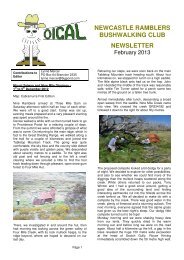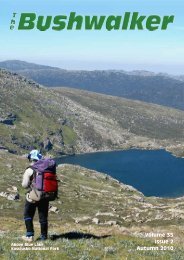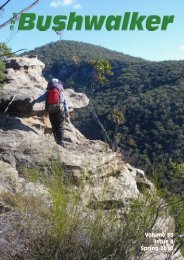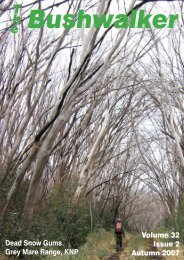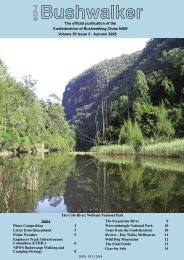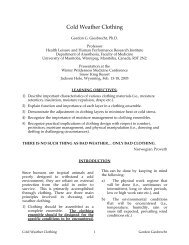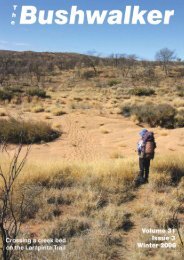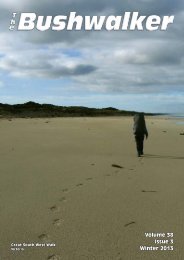Volume 32 Issue 1 Summer 2007 - Confederation of Bushwalking ...
Volume 32 Issue 1 Summer 2007 - Confederation of Bushwalking ...
Volume 32 Issue 1 Summer 2007 - Confederation of Bushwalking ...
- No tags were found...
Create successful ePaper yourself
Turn your PDF publications into a flip-book with our unique Google optimized e-Paper software.
fox and pitched our home-made tents on a<br />
thick layer <strong>of</strong> leaves, over a fine, loamy<br />
tilth. As night fell Wampoo Pigeons called<br />
from the forest, a soapy gargle, the last<br />
gasp <strong>of</strong> a drowning man, wam-poo, wampoo.<br />
A sugar glider called from a tree, no<br />
doubt attracted by our lights.<br />
Twenty seven years ago Franca left her<br />
university art course in Victoria, bought a<br />
share in the Tuntable Community, lived in<br />
a tent, knocked up a shack, built a house<br />
and had babies. In 1973 I had just<br />
graduated from university and heard <strong>of</strong><br />
the Aquarius Festival in Nimbin. People,<br />
hippies some would call them, were<br />
coming up here and starting communities.<br />
Franca on the abandoned Kunghur Flying Fox<br />
I decided not to, but ended up here<br />
anyway 33 years later. Franca, a<br />
vegetarian, munches into some nori she<br />
had made earlier. I tell her nothing <strong>of</strong> my<br />
meal which has home-grown beef in it.<br />
Specifically a Murray Grey heifer that I<br />
watched being born, lovingly tended for<br />
18 months and, in an act <strong>of</strong> betrayal, sent<br />
to the place where the knives are sharp.<br />
All our food has a history, a life story.<br />
Not much chance <strong>of</strong> sleeping through<br />
the first-light chorus <strong>of</strong> birds in the<br />
forest. Our packs were significantly<br />
lighter, each <strong>of</strong> us had brought 6 litres <strong>of</strong><br />
water. Temperatures <strong>of</strong> 29 degrees were<br />
predicted. A first for me was the wearing<br />
<strong>of</strong> leather gloves to grasp the thorns that<br />
would ensnare me. Franca carried a pair<br />
<strong>of</strong> seceteurs to deal with the lawyer vines.<br />
Either way we had to wait-a-while.<br />
On the way out we ran into Sandy and<br />
Rob. They were <strong>of</strong>f to do much the same<br />
walk as we had hoped to do. Their plan<br />
was to sleep on the top <strong>of</strong> Sphinx Rock<br />
that night and continue over the top <strong>of</strong><br />
Blue Knob, ending on the Blue Springs<br />
Community. They have done the trip<br />
before and gave us all the instructions we<br />
needed yesterday. For the time being<br />
Sphinx Rock was, for us, an unfinished<br />
project.<br />
We soon passed a dozen members <strong>of</strong><br />
the The Nimbin Bushwalkers Club who<br />
had come out to meet us on a day walk.<br />
They needed to climb a mountain before<br />
turning back, so we left them to it.<br />
National Parks have taken all references to<br />
this track <strong>of</strong>f their brochures and signage.<br />
It was good to see it still being used.<br />
Franca decides to go back and finish her<br />
university art course next year, and I<br />
resolve to try and embrace some <strong>of</strong> the<br />
Aquarius values. Nimbin is that sort <strong>of</strong><br />
place.<br />
<strong>Volume</strong> <strong>32</strong>, <strong>Issue</strong> 1, <strong>Summer</strong> <strong>2007</strong><br />
Ian Brown<br />
Alarge and controversial bushfire<br />
burnt the upper Grose Valley last<br />
November. While thankfully no<br />
human lives and property were lost, the fire<br />
burnt some 15,000 hectares <strong>of</strong> Blue<br />
Mountains National Park (and World<br />
Heritage Area), much <strong>of</strong> it to a high<br />
intensity, and damaged rare plant sites and<br />
many kilometres <strong>of</strong> walking track. Fire<br />
suppression costs were up to $500,000 a<br />
day just for aircraft, and the final cost will<br />
exceed $10 million. The park restoration<br />
costs and environmental impacts are<br />
unknown, but the long-term protection <strong>of</strong><br />
Grose Valley ecosystems are threatened by<br />
too-frequent fire.<br />
Blue Gum Forest burnt in a very hot<br />
head fire on the ‘blowup’ day <strong>of</strong> 22<br />
November which threw spots 12 km in front<br />
<strong>of</strong> the fire. It was the third time the nearsacred<br />
forest has burnt in 24 years (1982,<br />
1994 and 2006), and this was the hottest.<br />
About 80% <strong>of</strong> the canopy was scorched and<br />
most <strong>of</strong> the understorey removed. The<br />
future <strong>of</strong> many trees is uncertain.<br />
These impacts were seen by many as<br />
unnecessary and produced a groundswell <strong>of</strong><br />
concern in the Blue Mountains and<br />
conservation communities. <strong>Issue</strong>s included<br />
the failure to suppress the fires while small,<br />
the large extent <strong>of</strong> backburning under<br />
severe conditions, the escape <strong>of</strong> some<br />
backburns, the lack <strong>of</strong> recognition <strong>of</strong><br />
heritage values, the power <strong>of</strong> the RFS, the<br />
cost, the burning <strong>of</strong> Blue Gum Forest, the<br />
media ‘spin’ and the long-term survival <strong>of</strong><br />
park ecosystems. A particular concern was<br />
the dominance <strong>of</strong> road-based strategies and<br />
resources over remote area (helicopterbased)<br />
firefighting capability. Would<br />
greater investment in remote area crews<br />
have paid <strong>of</strong>f in a much smaller (and<br />
cheaper) fire<br />
The outcry included a full page<br />
statement in the local newspaper funded by<br />
143 residents (I was one). It pointed out<br />
that the Grose Valley is burning too <strong>of</strong>ten,<br />
noted the threat <strong>of</strong> increased fire with<br />
global warming and called for an<br />
independent review <strong>of</strong> the fire. The Sydney<br />
Morning Herald ran an ‘expose’ by a local<br />
journalist, in which Keith Muir <strong>of</strong> the<br />
Colong Foundation queried whether Blue<br />
Gum had been sacrificed. It also reported<br />
disputes within the multi-agency fire team<br />
over how to manage the fire. In the local<br />
paper, former NPWS Blue Mountains fire<br />
ecologist Nic Gellie published a critique <strong>of</strong><br />
the fire control strategies. Most<br />
commentators did not criticise those who<br />
worked on the fire, including many<br />
hundreds <strong>of</strong> Rural Fire Service (RFS)<br />
volunteers.<br />
The public reaction from RFS<br />
Commissioner Phil Koperberg (who<br />
was the new state Labor candidate for the<br />
seat <strong>of</strong> Blue Mountains) and sitting local<br />
member (and Minister for the<br />
Environment) Bob Debus was rapid and<br />
vigorous. They denounced critics, said the<br />
‘campaign’ was ‘political’, praised<br />
volunteers, refused to acknowledge any<br />
problems (despite the facts) and denied a<br />
review. Now that some time has passed,<br />
and more issues with the fire have come to<br />
light, local critics and conservation groups<br />
Walk Safely—Walk with a Club<br />
Blue Gum Forest Burns Again<br />
are pursuing discussions with RFS, NPWS<br />
and others to seek better management <strong>of</strong><br />
fires for the future.<br />
While the ‘fog <strong>of</strong> fire’ still surrounds the<br />
full story, more facts are becoming clear.<br />
The first few days were critical to later<br />
events. The fire began with two separate<br />
ignitions. A lightning strike was spotted on<br />
Burrakorain Head on 14 November and<br />
attacked by NPWS remote area firefighters.<br />
Good progress was disrupted when their<br />
two helicopters were diverted to a second<br />
ignition (suspected lightning) west <strong>of</strong><br />
Darling Causeway in the Hartley Valley.<br />
In a stiff westerly wind, this second fire<br />
moved quickly up to the causeway, where<br />
extensive backburning was undertaken. A<br />
combination <strong>of</strong> the head fire and backburns<br />
crossed the road-railway corridor in many<br />
locations that night and spread into the<br />
national park in the head <strong>of</strong> the Grose<br />
Valley. These were not contained, and<br />
meanwhile the unattended Burrakorain fire<br />
had Talso spread significantly.<br />
he decision was taken to fall back to a<br />
large area backburn around the north<br />
<strong>of</strong> Blackheath and Mount Victoria and<br />
along Bells Line <strong>of</strong> Road. Several lines<br />
were attempted to hold the fire across the<br />
valley between Pierces Pass and Banks<br />
Wall, but more backburn escapes in<br />
worsening conditions caused these to fail.<br />
One breakout sent fire across Thunder<br />
Gorge towards Mount Tomah and another<br />
near Anvil Rock sent fire into the valley<br />
towards Blue Gum and around the<br />
escarpment towards Blackheath.<br />
When all this fire, enlarged by<br />
backburns, blew up on 22 November it ran<br />
east into the area burnt in the 2002 Mt Hay<br />
fire. Low fuels combined with an easterly<br />
weather change enabled close containment<br />
to finally work – but the fire also threw<br />
spots beyond the 2002 fire to threaten the<br />
lower mountains. A huge extension <strong>of</strong> the<br />
backburn to Faulconbridge (and the entire<br />
Grose Valley), pushed by some in the RFS,<br />
was only narrowly averted by damp<br />
weather and RAFT suppression <strong>of</strong> the<br />
spotovers.<br />
The upshot is that all <strong>of</strong> the upper Grose<br />
Valley from near Mt Hay has been burnt,<br />
including Govett Gorge and parts <strong>of</strong> the Mt<br />
Hay plateau. The valley and all walking<br />
tracks between Mt Victoria and Evans<br />
Lookout will remain closed until<br />
reconstruction can be completed. Whether<br />
any <strong>of</strong> this could have been avoided by<br />
better initial attack or different strategies<br />
will be debated for some time, as will longterm<br />
improvements in fire suppression for<br />
our national parks.<br />
[Ian has attempted to be fairly neutral<br />
about the RFS management <strong>of</strong> the<br />
firefighting as he is still involved in the<br />
assessment process. I have seen and wept<br />
over the carnage inflicted by the methods<br />
used to handle the whole fire incident.<br />
Surely we can do better than to control<br />
burn the entire Grose Valley just to protect<br />
a few bits <strong>of</strong> badly-sited private property -<br />
Editor]<br />
Ian Brown is a Bushwalker, former NPWS<br />
Ranger and Operations Manager with 20<br />
years firefighting experience (mostly in<br />
Blue Mtns) and currently an environmental<br />
consultant<br />
The Bushwalker | 11



